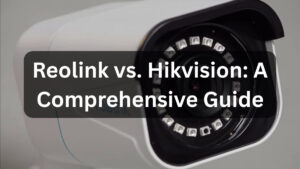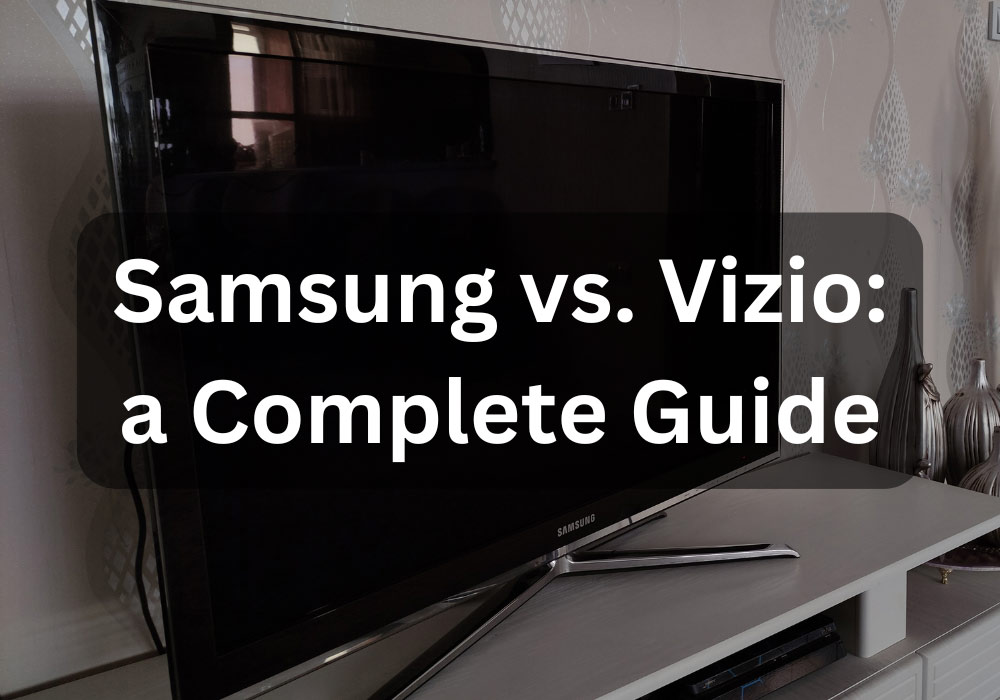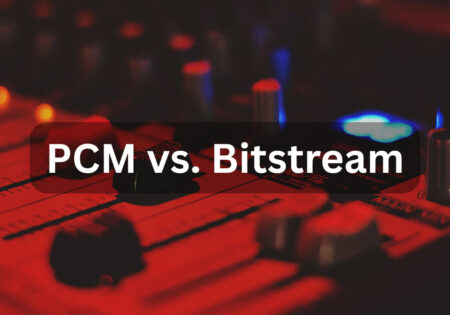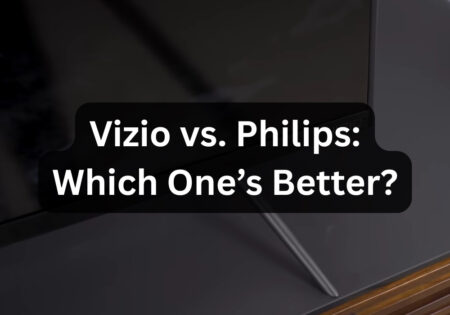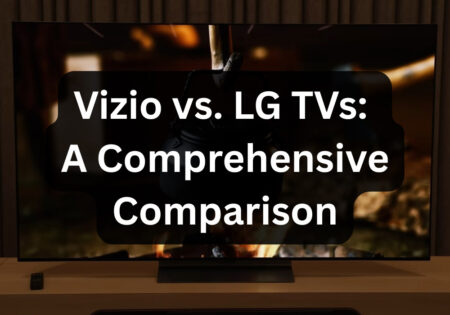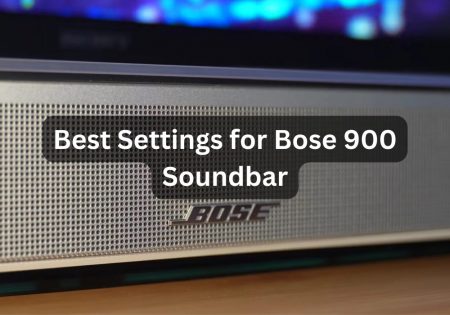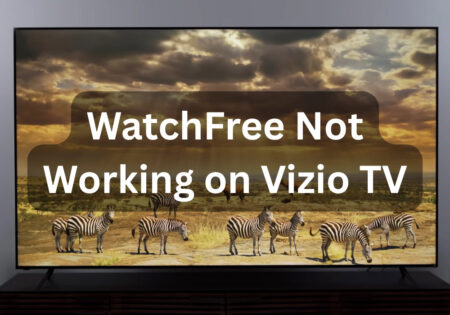Picking a winner in Vizio vs. Samsung isn’t easy since both brands have 4K UHD, OLED, and QLED TVs packed with cool features. Vizio has the upper hand regarding affordability, but Samsung is famous for its innovations and premium design. In this review, I will share my experience and compare picture quality, TV features, gaming performance, and more.
Which Brand Is Better, Samsung or Vizio? (Quick Answer!)
Alright, I’m going to spoil everything here by declaring Samsung as the clear winner here. Their TVs are perfect when it comes to picture quality, gaming, and design. Their QLED, Neo QLED, and QLED displays are amongst the sharpest displays in the market.
Higher brightness, super-fast refresh rates, and better smart features are all reasons to see Samsung a better choice here. What’s the downside? Well, clearly all those perfect features aren’t so cheap! Compared to Vizio, Samsung TVs are pricier.
On the other hand, Vizio can offer you some reliable 4K HDR TVs without losing an arm or a leg like you would with a Samsung. The purchase value is quiet impressive, you have Quantum Dot technology and full-array local dimming at lower prices. However, their software is filled with apps that can become a nightmare sometimes.
In addition, if you’re looking for a budget TV that offers good value, I suggest you read my Vizio vs. Hisense and Vizio vs. TCL guides as well.
Here’s a table to compare Vizio and Samsung at a glance:
| Feature | Samsung (QLED, Neo QLED, OLED) | Vizio (M-Series, P-Series, V-Series) |
|---|---|---|
| Picture Quality | Superior (QLED, Neo QLED, OLED, Mini-LED) | Good (Quantum Dot, Full-Array LED) |
| Brightness & HDR | Higher brightness, HDR10+, Dolby Vision (on OLED) | Decent brightness, Dolby Vision, HDR10 |
| Smart TV OS | Tizen OS (Fast, polished, SmartThings) | SmartCast (Ad-heavy, slower, no app store) |
| Gaming Performance | 120Hz, VRR, FreeSync, Game Mode, HDMI 2.1 | 120Hz on select models, inconsistent firmware |
| Audio Quality | Object Tracking Sound, Dolby Atmos, Q-Symphony | DTS Virtual:X, decent but lacks refinement |
| Design & Build | Ultra-thin, premium materials, lifestyle models | Bulkier, plastic-heavy, functional design |
| Advertisements | Some home screen ads, but less intrusive | Heavy ads, pop-ups during live TV |
| Price Range | Higher ($500 – $5,000+) | Lower ($200 – $2,000) |
| Best For | High-end performance, gaming, premium home theaters | Budget buyers, secondary TVs, casual viewing |

Vizio vs. Samsung: Brand Overview
Vizio: Budget-Friendly with a Focus on Value
Vizio, an American brand selling TVs since 2002, quickly became popular for its budget-friendly 4K UHD and HDR models. Unlike the big tech companies, Vizio mainly produces TVs and soundbars and offers models with interesting options, such as Dolby Vision and SmartCast OS.
One reason Vizio TVs are cheaper is that the company mainly profits from advertisements and pre-installed applications on the TV. However, this brand’s M-Series Quantum and P-Series Quantum X models can compete with high-end brand TVs regarding color accuracy, contrast, and local exposure performance.
Also Read:
Best Vizio Smart TVs
Samsung: A Global Leader in TV Innovation
On the other hand, Samsung is a South Korean electronics company that has been in the TV industry since 1969. Ever since, Samsung has been one of the greatest pioneers in the TV market, with premium picture quality, cutting-edge innovative features, and QLED and Mini-LED technology.
Samsung’s Tizen OS is smooth and fast, plus it works perfectly with Samsung phones and smart home devices. In addition, Samsung’s top-tier models, like the Neo QLED 8K and The Frame, have amazing visuals, anti-glare screens, and AI features.
Also Read:
Best Samsung Smart TVs
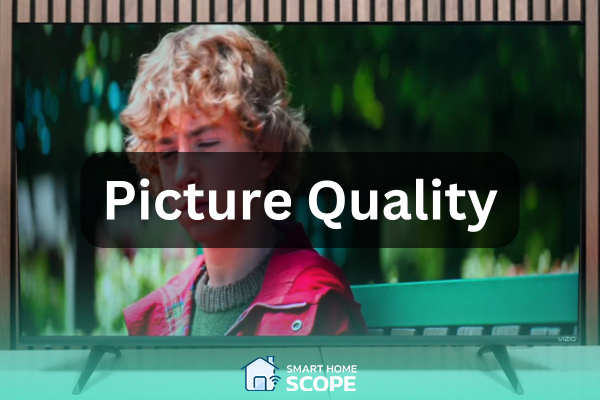
Samsung vs. Vizio: Picture Quality
Samsung: A Market Leader with Innovative QLED and Neo QLED Technologies
Samsung TVs have two main lines of display technology.
First, there is the Quantum Dot technology (QLED) that effectively enhances color vibrance. This makes their TVs perform very well in HDR and daylight visibility. The QLED panels offer HDR10+ and anti-glare coating, making the images pop even in super-bright rooms.
Their second lineup is equipped with Neo QLED, which is powered by Mini-LED backlighting. I can’t emphasize how effective the tech is in improving contrast and black levels; it is much better than QLED displays.
Not to be left out is their 8K upscaling feature, a Neo Quantum processor powered with AI that can increase the resolution of older content; it can effectively make 4K and HD content sharper.
Vizio: 4K with Quantum Color Displays at an Affordable Price
Vizio’s M-Series and P-Series are valuable offers since they come with 4K HDR, which has recognizable color accuracy, and Full-Array Local Dimming (FALD), which can improve contrast by dimming darker areas.
Vizio TVs are equipped with VA panels that deliver deep blacks. However, these panels aren’t perfect because they don’t have wide viewing angles compared to Samsung’s IPS or OLED panels.
In addition, Vizio’s HDR support isn’t as great as Samsung’s. Vizio TVs do support Dolby Vision and HDR10, but their peak brightness is 600-1000 nits, which is lower than Samsung’s Neo QLED (+1500 nits).
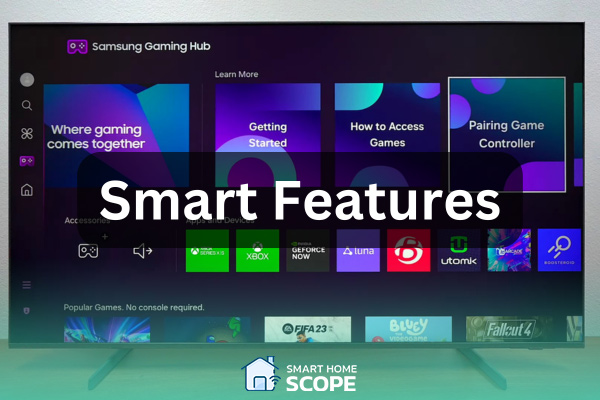
Smart TV Features and Operating System
Samsung’s Tizen OS: A Fast and Feature-Rich Experience
Samsung’s Tizen OS with Eden user interface is user-friendly and has a smooth design. You can open any app from the taskbar at the bottom of the screen and even preview content without stopping what you’re watching.
You get tons of apps, including popular streaming services like Netflix, Apple TV, and HBO Max. In addition, Samsung TV Plus gives you free live channels, but with ads. The good news is that Samsung TVs do more than just stream shows; they can also control smart home gadgets like thermostats and security cameras.
A cool thing about Tizen OS? You can control it using Bixby, Google Assistant, or Alexa. That means you can search, tweak settings, or control your smart home, all without touching the remote.
Also, the Multi-View feature is handy for gamers and those who do several things at the same time. With this feature, you can see two contents simultaneously, for example, you can have on one side, the live TV screen, and the other side, the phone screen. Of course, Samsung shows ads, but compared to Vizio, they’re less annoying.
Vizio’s SmartCast: Simple but Ad-Heavy
Vizio TVs have their own OS called SmartCast, which is a little different from what you see in other TVs. Instead of having an app store where you can download any app you want, like Samsung, it is mainly based on built-in Chromecast and Apple AirPlay. That means if you want to watch a movie, you have to play it directly on the TV from your phone or laptop.
This is convenient for those who constantly work with their phones and watch movies and series from there. Still, if you are used to installing all the apps directly on the TV, this feature might be a bit limiting.
One thing that bothers some people is that Vizio profits from ads, so when you turn on the TV, you may see advertising banners in the menu or even a series of pre-installed applications. Sometimes, pop-up ads may appear even when you are watching a live program, which is annoying for many.
Another advantage of Vizio, which improves functionality over time, is that it provides software updates to older models.
Who Wins the Smart Features Battle?
Samsung TVs have a unique operating system called Tizen OS, which is better than many competitors in terms of speed, number of applications, and features. If you want a smooth and feature-packed smart TV, Samsung is a better option because it works faster, its applications are easier to access, and it can coordinate very well with other smart devices at home.
On the other hand, the SmartCast operating system in Vizio TVs is simpler and more designed for broadcasting content from a phone or laptop. Still, because it has many ads, working with it may become a little annoying.
| Feature | Samsung (Tizen OS) | Vizio (SmartCast) |
|---|---|---|
| App Store | Large selection | No native store (relies on casting) |
| Smart Home Hub | SmartThings Integration | Limited compatibility |
| Voice Assistants | Bixby, Alexa, Google Assistant | Alexa, Google Assistant, Apple HomeKit |
| Built-in Casting | No (requires separate Chromecast) | Yes (Chromecast + AirPlay) |
| Ad Presence | Moderate ads | More intrusive ads |
Samsung TVs boast Tizen OS, delivering a sleek, feature-rich experience, while Vizio’s SmartCast OS favors simplicity but is cluttered with ads
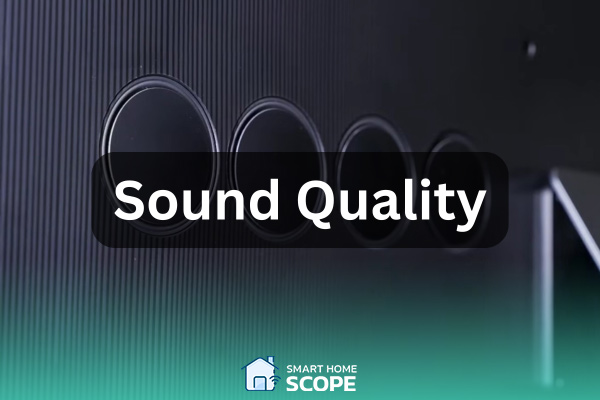
Audio Performance and Sound Quality
Samsung: Immersive Audio with Advanced Processing
Samsung has done a great job with the sound quality of its TVs. Models like the QLED and OLED models are combined with Object Tracking Sound (OTS) technology. This system dynamically adjusts sound based on on-screen movement and gives you a more realistic and three-dimensional feeling.
In high-end models like QN90C and S95C, Dolby Atmos is added, making dialogues clearer and action scenes look more exciting.
Another interesting feature that Samsung has is Q-Symphony. This feature synchronizes audio with Samsung soundbars, giving a fuller and more balanced soundstage.
In addition, in high-end models, Samsung has used a Neural Quantum processor that optimizes the sound with the help of artificial intelligence, makes dialogues clearer, adjusts the sound volume according to the content you are watching, and strengthens the sound bass.
However, the internal speakers may be weak in Samsung’s cheaper models, and the sound seems thin. Still, the high-end models of this brand offer one of the best audio experiences without the need for an additional speaker.
Vizio: Strong Sound for the Price, but Lacks Refinement
Vizio performs very well in terms of sound quality in budget and mid-range TVs and challenges its competitors in the same price range.
Many M-Series and P-Series Quantum models are equipped with DTS Virtual:X technology, creating virtual surround sound. Although it’s not as advanced as Samsung’s OTS technology, it helps the sound to be more expansive. In addition, most Vizio TVs also support Dolby Audio, which makes the dialogues clearer and the bass sound work well.
One area where Vizio still has to improve is its sound processing and quality stability in different conditions. The internal speakers of this brand’s TVs usually have good sound power and provide decent bass, but if you turn up the volume too much, the sound quality may be distorted, and the dialogue in the action-heavy scenes may be lost.
Unlike Samsung, which allows the TV’s sound to be synchronized with the soundbar perfectly with Q-Symphony technology, Vizio TVs do not have such a feature and depend on the same internal speakers.
However, Vizio also produces a series of affordable soundbars, which are excellent products for many users. Pairing 5.1 channel models or soundbars equipped with Dolby Atmos with its TV can compensate for the weakness of the internal speakers and provide a much better audio experience.
Which Brand Offers TVs with Better Audio Quality?
Samsung offers a much better audio experience in high-end models, and innovative technologies make the dialogues clearer and engaging.
On the other hand, Vizio provides surprisingly good built-in audio for budget-friendly TVs, but it lacks advanced sound optimization and seamless soundbar integration. If sound quality is very important to you and you don’t want to buy a separate speaker, Samsung is a better choice.
For those with a limited budget who don’t mind using a separate soundbar, Vizio with a 5.1 or Dolby Atmos soundbar can also be a good option.
| Feature | Samsung | Vizio |
|---|---|---|
| Surround Sound Technology | Object Tracking Sound (OTS) | DTS Virtual:X |
| Dolby Atmos Support | Yes (High-end models) | Limited (Select models) |
| Soundbar Synchronization | Q-Symphony (Pairs with Samsung soundbars) | No advanced synchronization |
| AI Sound Processing | Yes (Enhances dialogue & adjusts volume) | No AI-based sound processing |
| Bass & Volume Consistency | Strong and balanced | Can distort at high volumes |
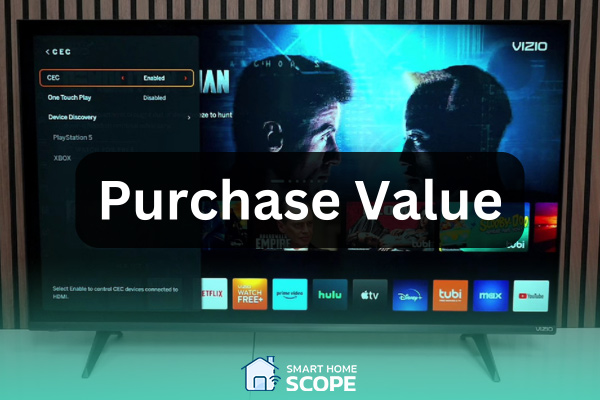
Samsung vs. Vizio: Price and Purchase Value
Vizio: Affordable TVs with Impressive Features in Their Price Range
When it comes to cost, Vizio has the upper hand. This brand has models like 4K UHD and HDR TVs that are more accessible for those who don’t want to spend a lot.
The D-Series and V-Series are among the most affordable 1080p and 4K TVs on the market and typically retail for under $500. But, the M-Series Quantum and P-Series Quantum X series offer quality close to Samsung’s QLED models but at a lower price if you are looking for a balanced model in terms of cost and quality.
However, a lower price comes with some limitations. The body of Vizio TVs is mostly made with plastic. In terms of brightness, refresh rate, and lower-quality image processing, Vizio TVs can’t match Samsung’s.
On the other hand, as Vizio makes part of its revenue from advertising, you have to deal with ads on the home screen and even occasional pop-ups while watching, whereas Samsung TVs have fewer ads.
Samsung: More Costly, But Offer Many Advanced Technologies
Samsung costs more, but it offers better image quality and features, as well as long-term reliability. Affordable Samsung models like the TU7000 and AU8000 usually cost between $400 and $600, which is more expensive than Vizio’s affordable TVs. But with its Tizen OS, decent image processing, and better-quality control, it’s a more reliable option for long-term use.
If you are looking for a mid-range model, Samsung Q60C and Q70C QLED TVs are good options. These models have better brightness, color accuracy, and motion clarity and are usually priced between $700 and $1,200.
If you are looking for a premium model, Neo QLED QN90C or OLED S95C are Samsung’s high-end choices with a price range of $1,500 to $3,000. These TVs use Mini-LED backlight, high contrast, and intelligent image processing with artificial intelligence, making their quality much higher than any Vizio model.
One reason Samsung’s price is higher is its better build quality, more advanced software, and more extended support for firmware updates. Samsung doesn’t have annoying ads like Vizio, but a series of recommended content is displayed on the main screen. Yet, Samsung’s ads are much less annoying, and the brand doesn’t aggressively use user data for commercials like its rival.
Who Wins on Purchase Value?
If you are looking for an economical TV with decent image quality and don’t want to spend a lot, Vizio is a better choice. This brand offers an acceptable experience at a lower price and is a good choice for secondary rooms, casual streaming, and gaming.
But if image quality is more important to you and you prefer a TV with a solid structure, advanced technologies, and long-term support, Samsung is worth the extra cost. This brand, with better screens, stronger software, and higher durability, is ideal for those who want to make a long-term investment in their TV.
In overall, if budget is your priority, Vizio wins, but Samsung is worth the extra cost if you want top-tier quality and longevity.
Vizio is a cost-effective option for casual use, while Samsung provides unparalleled quality and longevity for those seeking a premium, lasting investment
| Category | Vizio Price Range | Samsung Price Range | Best Choice |
|---|---|---|---|
| Entry-Level (1080p & Basic 4K) | $200 – $500 | $350 – $600 | Vizio (Better value for casual users) |
| Mid-Range (4K with Quantum Dot) | $500 – $1,200 | $700 – $1,500 | Samsung (Better picture quality and longevity) |
| Premium (OLED, Mini-LED, 8K) | $1,200 – $2,000 | $1,500 – $5,000+ | Samsung (Superior technology and build quality) |
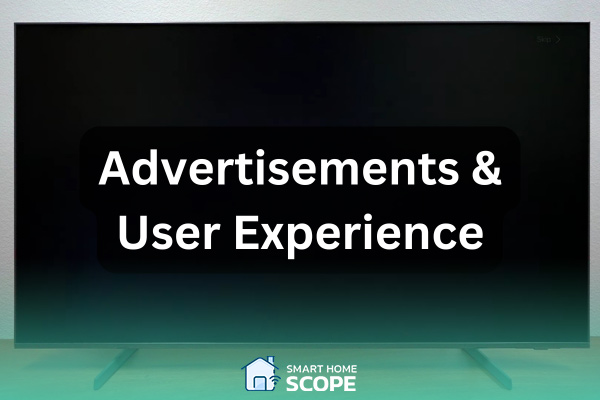
Samsung vs. Vizio: Advertisements and User Experience
Vizio: Too Much Ads Make the TV Less User-Friendly
Vizio keeps the price low by generating revenue through advertising and collecting user data. The company earns notable income by displaying ads on the SmartCast OS and tracking user behavior for third-party advertisers.
Vizio TVs come with banner ads on the home screen, pre-installed apps, and pop-ups that appear during live watching.
One of the most controversial things Vizio has done is in-content advertising. Some users report that banner ads appear on the screen while watching live shows, just like YouTube ads. This feature has not yet been widely implemented, but it shows that Vizio is very serious about making profits from TV advertising.
In addition, in SmartCast OS, there is no option to delete ads; even if you opt out of data collection, ads will still be displayed. This annoys those who like to have a clean and ad-free experience. These ads lower the cost of Vizio TVs, but they may not be enjoyable if you’re used to an ad-free experience.
Samsung: Ads Exist but are Less Common
Samsung also includes ads in Tizen OS, but less than Vizio. The primary form of advertising is suggested content on the home screen, which showcases movies, TV shows, and apps. Some people may feel it is redundant, but unlike Vizio, annoying pop-ups do not appear when regular watching.
Samsung does not display in-content ads during live TV broadcasts, making the experience of watching TV much cleaner and uninterrupted. Although Samsung also collects user data to optimize offers and ads, it allows users to limit ads’ personalization in the settings.
Additionally, Samsung doesn’t have many pre-installed extra apps. At setup, it might suggest a few apps, but you don’t have to deal with a bunch of unnecessary programs. This makes the user interface cleaner and the TV more straightforward to use.
Which Brand Offers Better User Experience?
For those who don’t like ads, Samsung is a better option. The SmartCast OS in Vizio TVs is very dependent on advertisements, and as a result, the user interface becomes more crowded and sometimes annoying.
Samsung’s Tizen OS offers a smoother and cleaner experience, and ads are less visible in its environment. Both brands collect user data and show ads. However, Samsung limits ads mostly to the home screen.
| Feature | Vizio (SmartCast OS) | Samsung (Tizen OS) |
|---|---|---|
| Banner Ads on Home Screen | Yes, prominent and frequent | Yes, but less intrusive |
| In-Content Advertisements | Yes (Testing pop-up ads on live TV) | No |
| Pre-Installed Apps | Many third-party apps, cannot always be removed | Some apps, mostly removable |
| User Data Collection | Aggressive, monetized heavily | Used for recommendations, can be limited |
| Option to Disable Ads | No | Limited, but less invasive ads overall |
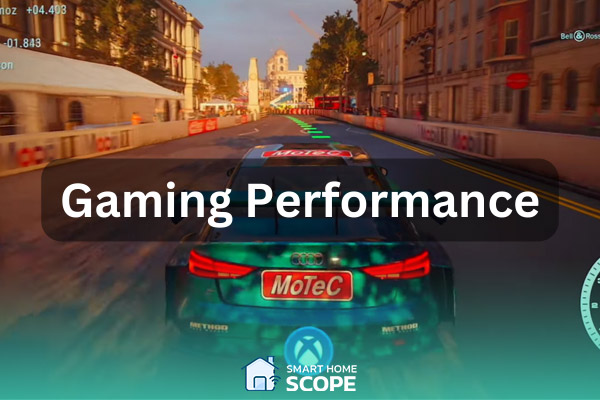
Gaming Performance
Samsung: Best for Competitive and Next-Gen Gaming
If you are a gamer looking for an ideal TV for gaming, do not hesitate to go for the QLED and OLED series of Samsung. Motion Xcelerator Turbo+ technology in models like QN90C and S95C OLED provides a smooth frame rate and 120 Hz refresh rate.
For competitive gamers, Samsung also offers FreeSync Premium Pro and VRR (Variable Refresh Rate), which reduces image tearing and lag in fast-paced games.
A very useful Auto Low Latency Mode (ALLM) feature automatically puts the TV on Game Mode when you connect the console. This feature reduces response time and minimizes input lag by around 5-10ms.
Also, HDMI 2.1 ports in some models allow you to play games with 4K and 120 Hz quality.
Another interesting feature for gamers is a dedicated menu where you can instantly adjust framerate and VRR settings without exiting the game called Game Bar 3.0.
Vizio: Solid Mid-Range Gaming, but Inconsistent Performance
Vizio has recently improved its gaming performance with its M-Series Quantum and P-Series Quantum X models. However, one problem gamers may face is inconsistent firmware updates that cause VRR and 120Hz performance to drop. This problem is improved in newer models.
Vizio’s main strength is offering good features at a lower price. M-Series and P-Series models support VRR and ALLM and keep the input lag around 10-15 milliseconds in game mode. Unfortunately, some users reported problems like Ghosting and Motion Blur.
Another limitation of Vizio is that not all of its models have HDMI 2.1, which means you are limited to 60 Hz in some budget-friendly models. This won’t be a problem for PS4, Xbox One, and Nintendo Switch consoles, but for PS5 or Xbox Series X at 120Hz, a Samsung QLED or OLED model is a safer choice.
Which Brand Will Be More Satisfying to Gamers?
Samsung is better for gamers because of its superior refresh rates and lower input lag. On the other hand, Vizio provides a good gaming experience at a low price, but it is less reliable for serious and competitive gamers. If you’re looking for the best gaming experience for PS5 or Xbox Series X, Samsung is the way to go.
Samsung boasts unparalleled refresh rates and near-zero input lag for avid gamers, while Vizio offers a budget-friendly, albeit less consistent, alternative for those seeking casual play.
| Feature | Samsung (QLED, Neo QLED, OLED) | Vizio (M-Series, P-Series) |
|---|---|---|
| Refresh Rate | Up to 120Hz (Some models support 144Hz) | 60Hz on most models, 120Hz on select models |
| Input Lag (Game Mode) | 5-10ms | 10-15ms |
| VRR Support | Yes (FreeSync Premium Pro) | Yes (Basic VRR) |
| Auto Low Latency Mode (ALLM) | Yes | Yes |
| HDMI 2.1 Ports | Available on most mid-range and high-end models | Only on select models |
| Special Gaming Features | Game Bar 3.0, Motion Xcelerator Turbo+, AI Upscaling | Basic VRR, inconsistent firmware updates |
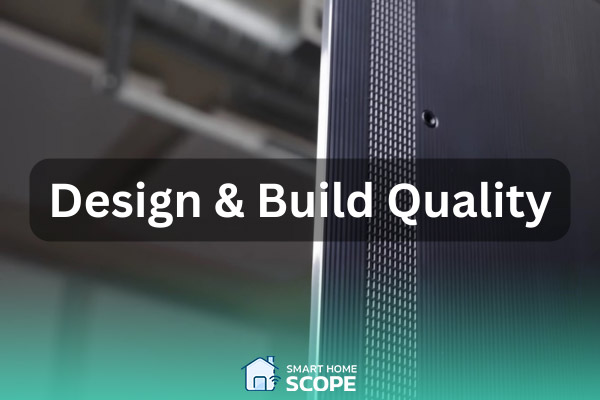
Vizio vs. Samsung: Design and Build Quality
Samsung: Perfect, Luxury Design; Very Minimal
Samsung pays excellent attention to design. Its advanced models have a modern and stylish appearance that easily matches any home’s decor. QLED and OLED models are very slim and have almost no bezels around the screen, making them look luxurious even when turned off.
In flagship models like the QN900C 8K Neo QLED, the Infinity Screen design makes the screen almost frameless and creates a feeling of a screen suspended in space.
Samsung offers The Frame, a unique lifestyle TV that doubles as a digital art display for those prioritizing home decor. It allows users to make the TV look like a framed painting rather than a traditional screen.
Another interesting feature of Samsung is the One Connect Box, which is available in some high-end models. This feature allows all the cables to be routed through a separate box, which is especially useful for wall installations because messy wiring is no longer needed.
Vizio: Larger Design, But not the Worst
Vizio TVs look traditional and focus on functionality rather than aesthetics. Even the advanced models have thicker bezels and heavier builds, making them look outdated compared to Samsung’s slim and modern TVs.
Vizio doesn’t offer models specifically designed to match home decor. Some models, like the M-Series Quantum, have a slimmer design, but you do not feel the elegance and charm of Samsung’s QLED models. Also, Vizio doesn’t offer a solution like Samsung’s One Connect Box, so if you care about tidying up the space around your TV, you must manage the various cables yourself.
Design and Build Quality Winner
Samsung has a complete advantage when it comes to design and beauty. This brand, with ultra-slim frames and unique models like The Frame, gives any space a modern and stylish effect. One Connect Box also helps to keep the space around the TV tidy and hides the extra wires from view.
In contrast, Vizio has a simpler design and focuses more on durability and strength. Although its models lack material and appearance innovations compared to Samsung, they are suitable options for those who prefer economic use and price to luxury design.
| Feature | Samsung (QLED, Neo QLED, OLED) | Vizio (M-Series, P-Series, V-Series) |
|---|---|---|
| Bezel Size | Ultra-thin, near bezel-less | Thicker bezels, bulkier design |
| TV Thickness | Ultra-slim (Premium models) | Standard thickness |
| Build Material | Premium materials, glass & metal on high-end models | Mostly plastic-heavy construction |
| Cable Management | One Connect Box for clean setups | No dedicated cable management system |
| Lifestyle TV Options | The Frame, The Serif, The Sero | None |
| Wall-Mount Friendliness | Slim fit wall-mount options, minimal gap design | Bulkier, may stick out more when mounted |
Conclusion
Going through a Samsung vs. Vizio article isn’t just enough. It’s important to consider your needs, and based on the features you need and your budget, you should make on a choice. Vizio’s a good choice for those who prioritize affordability. However, if money isn’t a big concern, Samsung wins in almost every other category, with better picture quality, nice designs and a strong build, and awesome gaming features.
